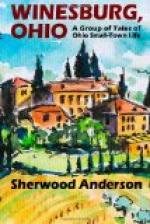George Willard and the telegraph operator came into the main street of Winesburg. The lights from the store windows lay bright and shining on the sidewalks. People moved about laughing and talking. The young reporter felt ill and weak. In imagination, he also became old and shapeless. “I didn’t get the mother killed,” said Wash Williams, staring up and down the street. “I struck her once with a chair and then the neighbors came in and took it away. She screamed so loud you see. I won’t ever have a chance to kill her now. She died of a fever a month after that happened.”
THE THINKER
The house in which Seth Richmond of Winesburg lived with his mother had been at one time the show place of the town, but when young Seth lived there its glory had become somewhat dimmed. The huge brick house which Banker White had built on Buckeye Street had overshadowed it. The Richmond place was in a little valley far out at the end of Main Street. Farmers coming into town by a dusty road from the south passed by a grove of walnut trees, skirted the Fair Ground with its high board fence covered with advertisements, and trotted their horses down through the valley past the Richmond place into town. As much of the country north and south of Winesburg was devoted to fruit and berry raising, Seth saw wagon-loads of berry pickers—boys, girls, and women—going to the fields in the morning and returning covered with dust in the evening. The chattering crowd, with their rude jokes cried out from wagon to wagon, sometimes irritated him sharply. He regretted that he also could not laugh boisterously, shout meaningless jokes and make of himself a figure in the endless stream of moving, giggling activity that went up and down the road.
The Richmond house was built of limestone, and, although it was said in the village to have become run down, had in reality grown more beautiful with every passing year. Already time had begun a little to color the stone, lending a golden richness to its surface and in the evening or on dark days touching the shaded places beneath the eaves with wavering patches of browns and blacks.
The house had been built by Seth’s grandfather, a stone quarryman, and it, together with the stone quarries on Lake Erie eighteen miles to the north, had been left to his son, Clarence Richmond, Seth’s father. Clarence Richmond, a quiet passionate man extraordinarily admired by his neighbors, had been killed in a street fight with the editor of a newspaper in Toledo, Ohio. The fight concerned the publication of Clarence Richmond’s name coupled with that of a woman school teacher, and as the dead man had begun the row by firing upon the editor, the effort to punish the slayer was unsuccessful. After the quarryman’s death it was found that much of the money left to him had been squandered in speculation and in insecure investments made through the influence of friends.




